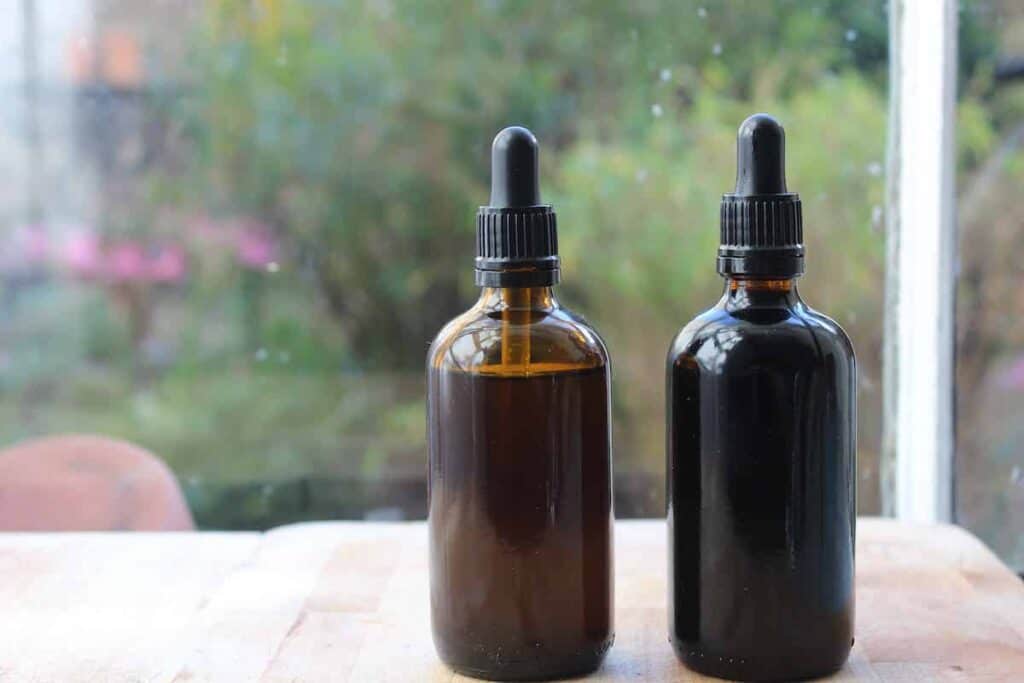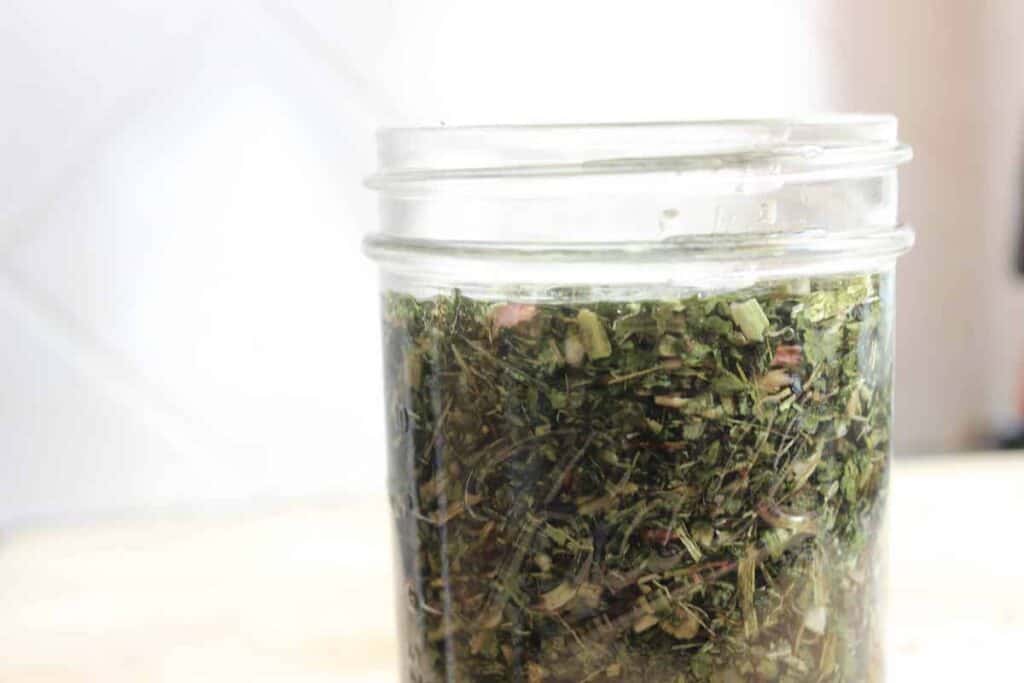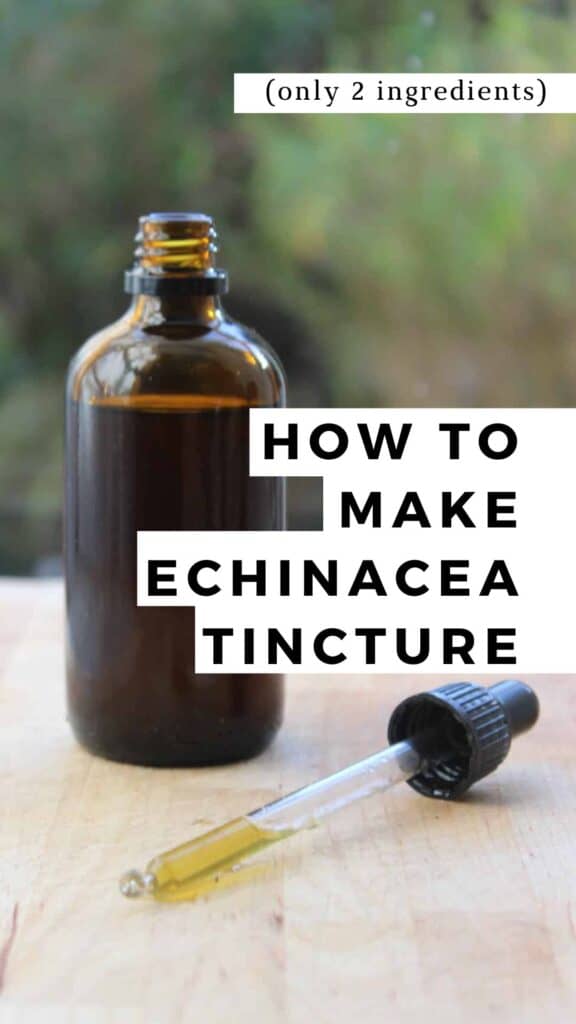Last Updated on June 1, 2025 by Nico
Echinacea tincture is a great natural remedy that can help prevent and recover more quickly from seasonal bugs. Homemade echinacea tincture uses only two ingredients and making your own is much less expensive than buying a storebought version.

Homemade herbal remedies are so simple and convenient to make. From fire cider and elderberry gummies to elderberry and nettle tincture, I’ve become a true believer in the benefits that herbal medicines can provide. With only two ingredients, making echinacea tincture is simple. You can store it away in your herbal medicine cupboard and whenever flu season is approaching or you feel under the weather you’ll have the remedy ready to use. It’s a staple in our household’s homemade medicine cabinet, especially in the winter months.
Less expensive…
Making echinacea tincture is also far less expensive than buying store-bought options. Where we live, it costs about $11 for one small bottle of the storebought tincture.
To make our own, we pay about $6 for a bag of organic echinacea, $20 for a 1-litre bottle of vodka, and $3 for an amber glass dropper bottle. This means that we can make 1 litre of tincture for less than $30 total, which makes the cost per dropper bottle only about $3. If you grow your own echinacea, it is even less expensive to make the tincture. You can even save the seeds from your flowers each year and have an endless supply of echinacea for years to come.
Watch The Video
History of echinacea tincture
From what I’ve read, echinacea tincture originates from US Native American culture and was particularly used by North American and indigenous tribes in the Great Plains of the states. They utilised echinacea for centuries as a traditional medicine to treat various ailments including infections, wounds, and respiratory issues.
What is echinacea tincture?
Echinacea is a purple coneflower that help keep our immune systems robust. Echinacea tincture is an alcohol-based extraction of the medicinal components found in the plant. By steeping the plant in alcohol, the alcohol draws out and preserves the medicinal compounds. Because the whole plant offers health benefits, you can use it all in your homemade tincture. Tinctures are a great way to preserve the medicinal properties of flowers like echinacea and other plants.
If you want to grow your own, the growing season of echinacea is from late spring (early April) with flowers appearing in late July. They continue to bloom until late August or early Septemeber if the weather stays mild. Echinacea grows best in dry prairies and open wooded areas with lots of sunlight.
Benefits Of Echinacea Tincture
Supports a robust immune system – Echinacea supports the body’s immune system and can help to reduce the severity and duration of colds and other respiratory infections.
Anti-inflammatory properties – Some research suggests that echinacea may have anti-inflammatory effects on the body, which could help alleviate discomfort from inflammatory conditions like arthritis.
Full of antioxidants – Echinacea contains compounds with antioxidant properties, which can help protect cells from damage caused by free radicals and oxidative stress.
Support skin and wound healing – When applied topically, echinacea tincture may aid in healing wounds. It may also help to reduce inflammation associated with minor injuries and skin conditions.
Antiviral and antibacterial effects – Some studies suggest that echinacea may have antiviral and antibacterial properties, which could potentially help combat certain infections (like ear infections and strep throat).
Support for upper respiratory tract illness – Echinacea tincture can be used to alleviate symptoms associated with upper respiratory tract infections, such as a sore throat, runny nose, cough, and congestion.
Folk Method
I like to use the folk method to make tinctures. The folk method is simpler because it uses less precise measurements than other methods. If you’re planning to make these tinctures to sell, however, it’s important to use precise measurements so that the final tinctures have the same nutritional values.
How To Make Echinacea Tincture
Tools
An airtight container with a plastic lid (like a mason jar) – I use a glass jar with a piece of parchment paper between the metal lid and tincture to prevent the alcohol from corroding the metal.
Knife – to chop up the echinacea
A small amber glass dropper bottle – I use these ones.
A fine mesh strainer or cheesecloth
A small funnel
Supplies
Fresh or dried echinacea – You can use the entire echinacea plant (roots, stems, leaves, and flowers)
80 proof vodka (or 40% alcohol) – If you want to avoid alcohol, you can simply swap out the alcohol for store-bought apple cider vinegar. If you’re using fresh plant material, consider using a stronger alcohol to offset the water content in the plant.
For complete measurements, see the printable recipe card below.

Instructions
Pro-tip: When to harvest echinacea
If you’re using fresh homegrown echinacea, the best time to harvest the plant or flowers is in the morning. This is because that’s when the nutrients in the flowers are at their highest levels. The oils in the plant tend to dissipate during the day due to increasing temperatures and sunlight exposure. By harvesting in the morning when the plant is still cool and the oils are most concentrated, your echinacea will contain the most beneficial properties.
If you’re using fresh echinacea, make sure to fully clean the plant, including the roots.
Begin your echinacea preparations by using a knife to chop up the entire plant (roots, stem, leaves, and fresh flowers). You could also use a food processor to make this faster. It’s good practice to chop up the plant into small pieces when making a tincture because it maximises how much of the plant is exposed to alcohol.
If you’re using dried herbs, it will likely already be chopped up.

Add all of the plant parts to a glass jar and fill it ¾ of the way full if you’re using fresh echinacea. If you’re using dried echinacea, fill the jar up ⅓ of the way full. This is to leave enough space for the dried plant to absorb the alcohol.
Cover the plant completely with alcohol.

Put a lid on the jar and tighten the lid. Shake the jar to ensure that everything in the jar is completely covered in alcohol.
Set the jar in a cool, dark place away from direct sunlight. Leave it for 4-6 weeks and try to shake it a few times a week. Shaking the jar helps to ensure the plant remains completely covered by the alcohol.
After 4-6 weeks, use a fine mesh strainer or cheesecloth to strain off the plant material from the liquid. The tincture will smell very earthy and will be dark in colour. If you’re using dried echinacea, I’d recommend using cheesecloth, to ensure that you completely remove the plant material from the liquid. Leaving plant material in the final tincture can result in the tincture going bad more quickly.
Use a small funnel to pour the strained liquid into the amber glass dropper bottle.
It’s a good idea to label and date the bottle so you remember what it is. Store the herbal tincture away from direct sunlight.
How much echinacea tincture to take?
I like to consume 1 dropper full (roughly 1 teaspoon) preventatively 3 times per day during September – March. If you are ill, you can increase the dosage to 2-3 droppers per day.
How long will echinacea tincture last?
Alcohol-based tinctures last a long time. If you ensure that the plant material is removed from the alcohol before storing the tincture and you keep it in a cool, dark, and dry place, the tincture should last 2-3 years.
How to Use Homemade Echinacea Tincture
Directly under your tongue – Echinacea tincture has a bitter flavour so I like to dilute it in a drink but you can also add a dropper full under your tongue to quickly absorb the beneficial compounds.
Diluted in water, juice, or tea – Add a dropper full into a glass of water, juice, or a cup of tea. I don’t notice the tincture taste when I dilute it like this.
In a hot cup of echinacea tea – You can add the dosage to a cup of echinacea tea to boost the medical benedits you get on one sitting from the plant.
Mixed into smoothies – I like to add a dropper full to my smoothie at breakfasttime
Topically – You can add a few drops into a pump of your favourite lotion and apply it to areas that are irritated.
What’s the difference between echinacea angustifolia and echinacea purpurea?
Echinacea angustifolia and Echinacea purpurea are two different species of echinacea. Both are commonly used for their potential health benefits such as immune support. However, they differ slightly in how they’re used. Echinacea angustifolia has a more potent root, which contains high levels of alkylamides which are supportive of the immune system. Echinacea purpurea has a broader range of active constituents, like polysaccharides and flavonoids, which are anti-inflammatory.
More echinacea tincture herbal remedy ideas
Immune support blend – You could combine echinacea tincture with other immune-boosting tinctures made with herbs like elderberry or ginger.
Respiratory support blend – You could mix echinacea tincture with tinctures made with thyme or licorice root to help soothe respiratory discomfort and alleviate coughs.
Anti-inflammatory blend – You could combine echinacea tincture with tinctures made from turmeric or ginger to help reduce inflammation in the body.
Stress relief blend – You could mix echinacea tincture with tinctures made from calming herbs like chamomile, lemon balm, or passionflower to help promote relaxation and reduce stress and anxiety.
Save it for later

What to read next
How To Make A Simple Blueberry Tincture
Herbal Remedies For Fall & Winter With Grass Roots Remedies
Simple Garlic Tea For Coughs And Colds
How To Make Elderberry Tincture
Elderflower Tincture – Simple Homemade Recipe
Simple DIY Rosemary Tincture Recipe
How To Make Lemon Balm Tincture
Thyme Syrup For Coughs And Colds

If you make this how-to and enjoy it, please consider giving it 5 stars. Find me on Instagram @documentingsimpleliving and show me what you’ve made!

How To Make Echinacea Tincture (Easy DIY Recipe)
Ingredients
Equipment
Method
- If you’re using fresh echinacea, make sure to fully clean the plant, including the roots.
- Begin your echinacea preparations by using a knife to chop up the entire plant (roots, stem, leaves, and fresh flowers). You could also use a food processor to make this faster. It’s good practice to chop up the plant into small pieces when making a tincture because it maximises how much of the plant is exposed to alcohol.
- If you’re using dried herbs, it will likely already be chopped up.
- Add all of the plant parts to a glass jar and fill it ¾ of the way full if you’re using fresh echinacea. If you’re using dried echinacea,
fill the jar up ⅓ of the way full. This is to leave enough space for the dried plant to absorb the alcohol. - Cover the plant completely with alcohol.
- Put a lid on the jar and tighten the lid. Shake the jart to ensure that everything in the jar is completely covered in alcohol.
- Set the jar in a cool, dark place away from direct sunlight. Leave it for 4-6 weeks and try to shake it a few times a week. Shaking the jar helps to ensure the plant remains completely covered by the alcohol.
- After 4-6 weeks, use a fine mesh strainer or cheesecloth to strain off the plant material from the liquid. The tincture will smell very earthy and will be dark in colour. If you’re using dried echinacea, I’d recommend using cheesecloth, to ensure that you completely remove the plant material from the liquid. Leaving plant material in the final tincture can result in the tincture going bad more quickly.
- Use a small funnel to pour the strained liquid into the amber glass dropper bottle.
- It’s a good idea to label and date the bottle so you remember what it is. Store the herbal tincture away from direct sunlight.
Video
Notes
How much echinacea tincture to take?
I like to consume 1 dropper full (roughly 1 teaspoon) preventatively 3 times per day during September – March. If you are ill, you can increase the dosage to 2-3 droppers per day.How long will echinacea tincture last?
Alcohol-based tinctures last a long time. If you ensure that the plant material is removed from the alcohol before storing the tinctureand you keep it in a cool, dark, and dry place, the tincture should last 2-3 years.
How to Use Homemade Echinacea Tincture
Directly under your tongue – Echinacea tincture has a bitter flavour so I like to dilute it in a drink but you can also add a dropper full under your tongue to quickly absorb the beneficial compounds. Diluted in water, juice, or tea – Add a dropper full into a glass of water, juice, or a cup of tea. I don’t notice the tincture taste when I dilute it like this. In a hot cup of echinacea tea – You can add the dosage to a cup of echinacea tea to boost the medical benedits you get on one sitting from the plant. Mixed into smoothies – I like to add a dropper full to my smoothie at breakfasttime Topically – You can add a few drops into a pump of your favourite lotion and apply it to areas that are irritated.Tried this recipe?
Let us know how it was!I’m not a medical professional and do not intend to offer medical advice in any content I create. I offer information for educational purposes and, as always, do your own research and speak to your doctor or paediatricians.
Leave a Reply